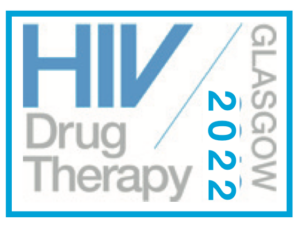Glasgow 2022: Fostemsavir 240 week results from BRIGHTE study
1 December 2022. Related: Conference reports, Antiretrovirals.
Kirk Taylor, HIV i-Base
 HIV Glasgow included two posters from the BRIGHTE study on week-240 efficacy of fostemsavir (FTR) in participants with extensive multidrug resistance. [1, 2]
HIV Glasgow included two posters from the BRIGHTE study on week-240 efficacy of fostemsavir (FTR) in participants with extensive multidrug resistance. [1, 2]
Virologic efficacy at week 96 (79%) was maintained through week 240 (82%). Viral load was <200 copies/mL for 92% and 77% of participants in the randomised (RC) and non-randomised (NRC) cohorts, respectively. Virological failure was more common for the NRC (54%) that were on functional FTR monotherapy due to failing optimised background therapy (OBT). [1]
Multivariate analysis showed that virologic response correlates with baseline viral load and CD4 count. Virologic failures were associated with GP120 mutations, baseline CD4 count and viral load but these were not predictive factors. [2]
Participants were enrolled into the RC (n=272, 3:1 FTR:placebo) or open-label NRC (n=99) arms and followed over five years. Participants were highly treatment experienced (HTE) with resistance to ≥1 class. Median baseline viral load and CD4 count was 4.6 log copies/mL (IQR: 1.6 to 6.9) and 80 cells/mm3 (IQR: 0 to 1160), with 30% of participants having a CD4 count <20 CD4 cells/mm3.
Week 240 interim analysis was performed to determine efficacy and safety of FTR + OBT beyond week 96. At week 240 virologic efficacy was maintained at 82% and viral load was <200 copies/mL for 92% and 77% of participants in the RC and NRC arms, respectively.
Virologic failure was higher in the NRC arm (54% vs 29%) reflecting greater baseline resistance. In the RC arm CD4 counts at week 240 were >200 cells/mm3 for 78% of participants, which included 22/33 participants who had <20 CD4 cells/mL at baseline. 60% of RC participants remained on FTR beyond week 240 and >80% had a viral load >40 copies/mL.
The safety profile was consistent with week 96 data. Six participants became pregnant during the study period with 3 normal pregnancies, 2 with complications (1 with foetal growth restriction and 1 premature birth) without congenital abnormalities and 1 pregnancy ended after an elective abortion.
The second poster was a post-hoc multivariate analysis of virologic outcomes where 65% of participants in the RC study achieved >0.5 log copies/mL decrease of viral load by day 8. For those with stable viraemia in the RC study (n=141), better virologic outcomes were associated with higher baseline CD4 count and viral load. GP120 mutations (S375H/I/M/N/Y, M426L and M434K) were associated with lower chance of viral load decrease. [2]
Protocol-defined virologic failure rates were 8% and 25% in the RC and NRC, respectively. Virologic response for both arms was associated with baseline CD4 count, viral load and PK parameters. GP120 mutations and lower efficacy of the OBT were associated with virologic failure in the NRC.
References
- Aberg J et al. Efficacy and safety of fostemsavir plus optimized background therapy in heavily treatment-experienced adults with HIV-1: Week 240 results of the phase 3 BRIGHTE study. Poster 061 HIV Drug Therapy, Glasgow 23 to 26 October 2022.
https://onlinelibrary.wiley.com/doi/10.1002/jia2.26009 (abstract)
https://virtual.hivglasgow.org/posters-exhibitions/posters/efficacy-and-safety-fostemsavir-plus-optimized-background-therapy (poster) - Gartland M et al. A multivariate analysis of the phase 3 BRIGHTE trial, trough week 24, to identify predictors of virologic response to fostemsavir in heavily treatment-experienced people living with HIV. Poster 064 HIV Drug Therapy, Glasgow 23 to 26 October 2022.
https://virtual.hivglasgow.org/posters-exhibitions/posters/multivariate-analysis-phase-iii-brighte-trial-through-week-24-identify

